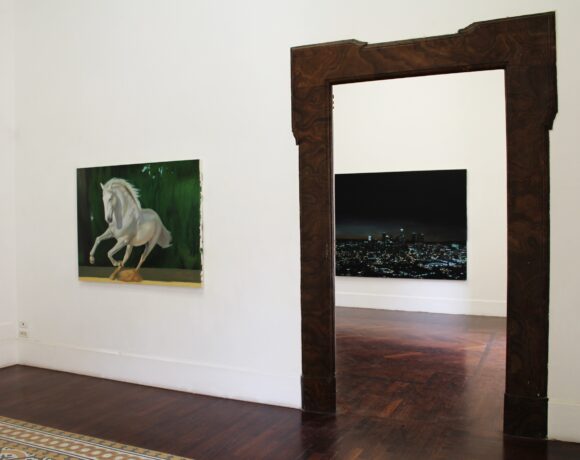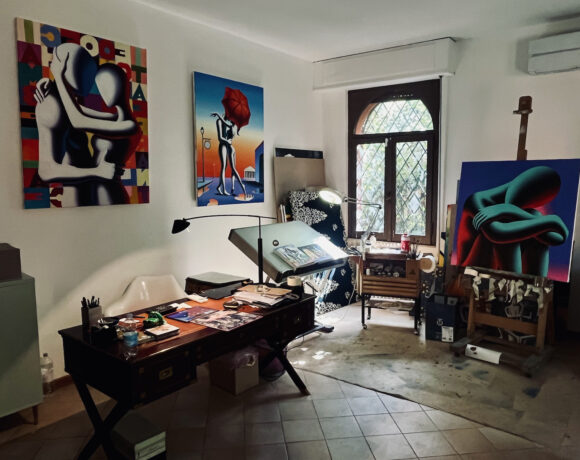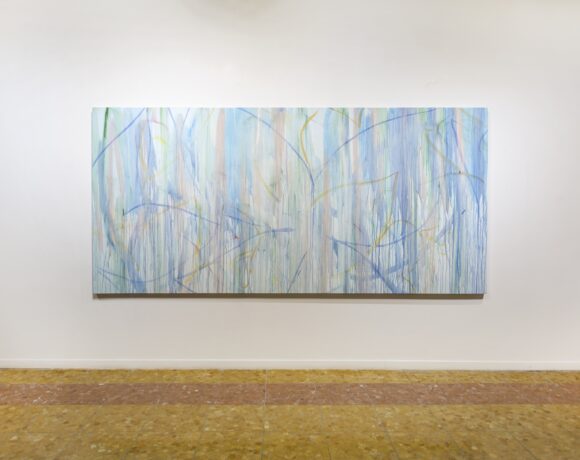In 1911 Sigmund Freud, in an essay on two principles that guide the functioning of our mind, suggested the idea that art was precisely a conciliation between two principles; pleasure and reality, and also presupposed a sort of balance between Eros and Thanatos.
The first consequence of this insight is that the work in its last essence is organic life, torn apart from the dispersion from which we come and towards which we are constantly pushed by destiny.
These concepts seem to be particularly relevant to accompany the observation of paintings by Iranian artist Mahin Monfared (Tehran, 1956), who, during her 20-year career, gave up a figurative and narrative dimension to follow the path of meditative immersion to take a holistic look at the world and return it in her mysterious entirety on canvas. The progressive elimination of the details in her painting seems to reflect a Neoplatonic perspective of existence.
If tangible reality is nothing more than a sign of a higher reality that contains and dominates us, in her paintings, she transcends the details to get away from the camouflage of the visible means. To purify it from any distraction and to express the beyond visual appearances as flawless as possible.
As the linear contours and hierarchies with which we’re usually accustomed to interpreting dissolve, colors become increasingly thematic, as if they were phenomena that show themselves and as such primary objects in the painting.
Large gestural brushstrokes overlap without mixing on the canvas: each of them, as a free tool for artistic creation, is the bearer of its intrinsic imponderability, but at the same time expresses its role in the painting only in relation to the other components of the pictorial structure.
The brush, by the color it carries, and the shape it embodies, when it deploys itself on the pictorial level (even without a prior established structure) detects relationships and correlations, compares the orifices, dialogs the different tones, and creates space.
In Mahin Monfard’s paintings, the eye is called upon to wander like a shuttle incessantly, cross the paint surface and experience its extension, holding the momentum to the depth and turning it into a spin-off drive towards the edges of the canvas beyond which the image seems to stretch indefinitely.
The artist has something elusive in the painting that may not be visible at first glance, yet it makes its perpetual change, seizing through the pictorial gesture, the primordial forms, and their movement, without giving in to the temptation to disperse energy into a hysterical divide.
For Mahin Monfared, painting has more to do with empathy and feeling than with representation; its abstract landscapes are intimate atmospheres, exciting dreams, or vigils where space perceived as a reflection of the cosmic totality. A possible new interpretation of the nature generated by the total spiritual interaction between the sentient and the world that embracing it.
If the painting becomes a metaphor for totality of the being, its cosmic unity presupposes an undifferentiated treatment of earth and sky, foreground and background, which confers identical materiality (or immateriality) at all levels of representation and it exclusively and psychologically orients the idea of depth that the overlapping of chromatic layouts continues to suggest.
If painting is applied as a tool for dematerializing the real, the brushstroke awaits only for an instinctive inspiration to shape and color an unspeakable motion of the soul. By explaining her feelings, the artist experiences her conscious and sensitive abilities and, at the same time, tests the pictorial means, explores them in their potential and, tries to overcome their limits.
Mahin Monfared’s landscapes are powerfully color-structured: the artist builds the painting using colorful masses that are now entirely independent of tangible reality, where the brushstrokes, accurate transcriptions of emotion at its peak of intensity, hold and emanate violent energy.
If the absence of recognizable shapes in a palette that continues to show a visceral attachment to real life could conjure delusional visions in the haze of uncertain memory, in the paintings of the Iranian artist, there seems to be no place for uncertainty and the confusion of things vanished.
Everything happens here, and now, Eros and Thanatos collide in the surfaces of color that overlap and contrast each other. The chromatic tensions do not allow the eyes to rest or color to change and move under the effect of the nearby tones.
The opposition generates a continuous movement between surfaces that lose compactness and incorporate the tone of the canvas and the background, to the point that everything becomes indifferently painting.
Adherence to gesture and the immediacy of perception does not, however, prevent the artist from steadily controlling the composition as a whole, which is always balanced both in its brightest contrasts and in areas where a delicate organization of shades structures the surface.
And perhaps Mahin Monfared’s most interesting ability lies right here, in his innate capacity to reconcile very different pictorial structures in a single vision: heavy brushes against thin chromatic surfaces, strong colors laid out with fluidity and vigorous textures, peremptory gestures and seismographic scriptures, splashes, scratches and straight lines.
The radical reduction of the formal apparatus allows it to compare itself to the color materiality in which it projects itself to take over the world and offer it as pure energy to the viewer.
Info:
 Mahin Monfared, Untitled. Acrylic on paper, 2019
Mahin Monfared, Untitled. Acrylic on paper, 2019
 Mahin Monfared, Untitled. Acrylic on paper, 2019
Mahin Monfared, Untitled. Acrylic on paper, 2019
 Mahin Monfared, Untitled. Acrylic on paper, 2019
Mahin Monfared, Untitled. Acrylic on paper, 2019

Actor and performer, he loves visual arts in all their manifestations.






NO COMMENT